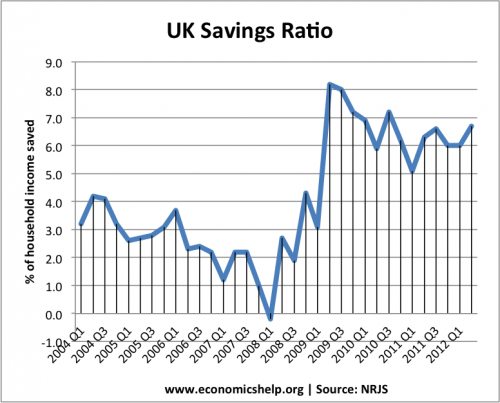Looking at graphs for the saving ratio, I noticed a paradox. When people felt it was a good time to save more, they actually saved less. When people felt it was a bad time to save, they actually save more.
Is it a Good Time to Save?
As part of the GFK consumer confidence survey. They ask a question – In view of the current economic situation – Is it a good time to save?

- During the period 2004 – May 2007, it is increasingly seen as a good time to save. In May of 2007, the index reaches a peak of +43.
- However, from 2008, this perception dramatically falls. By Feb 2009, most people are saying this is a bad time to save.
- During the period 2009-2012 the index is negative with most people saying this is a bad time to save.
But, What Happens to the Actual Savings Ratio?

When people think it is a good time (2004 -08) to save, the saving ratio is falling.
- The saving ratio becomes briefly negative in Q1 2008 – which ironically is close to the time when people are saying this is the best time to save.
- During 2009-12, when people think it is a bad time to save, the saving ratio increases to a much higher rate than the preceding years.
What does this suggest?
- It suggests that when people think it is a good time to save, they actually go out and spend, borrow on credit and reduce their saving.
- When people think it is a bad time to save, they actually save more of their income.
Note: The saving ratio measures saving as a proportion of income. During 2008-12, incomes were falling due to the recession. Therefore, that means that the actual value of savings was increasing even more than the rise in the saving ratio.
How Can we Explain this Paradox?
- When people are asked whether it is a good time to save, the question is likely to be interpreted as a general question on the state of the economy. When the economy is doing well (2004-08), people are likely to be optimistic, they will respond it is a good time to save. (they are more likely to respond – it is a good time to spend too)
- During the recession, people are pessimistic. With falling incomes and rising unemployment, the situation feels bad. People are pessimistic and so respond it is a bad time to save.
- During the recession, it probably really is a bad time to save. Incomes are squeezed, and people are having to cut back on essential items. It really is a bad time to save. However, this is outweighed by fears over future prospects so people hold back from big purchases. It may be a bad time to save, but it is an even worse time to buy a new car.
- During the boom years, people respond it is a good time to save. They are correct. Strong economic growth and a period of rising incomes mean it is a good time to save. However, we don’t always pursue our good intentions. We know it is a good time to save, but we don’t follow our good intentions, but spend instead.
Paradox of Thrift
This has interesting parallels with the concept of the paradox of thrift. Keynes noticed that in a recession.
- Individuals feel their best choice is to save more. Therefore, personal spending falls as people save in anticipation of possible unemployment.
- However, if many individuals save more, then this is bad for the macroeconomy. Because there is a rapid rise in the saving ratio, overall consumer spending falls and this makes the recession deeper.
- Therefore, the paradox of thrift states that although individual decisions to save more make sense from a personal perspective – overall, they are actually bad for the economy.
- This paradox of thrift is a justification for higher government borrowing during a period of higher private sector saving. The government spending offsets the fall in private sector spending.
- The paradox of thrift suggests that Say’s law (supply creates its own demand) will not occur.
Related

2 thoughts on “The Paradox of Saving”
Comments are closed.